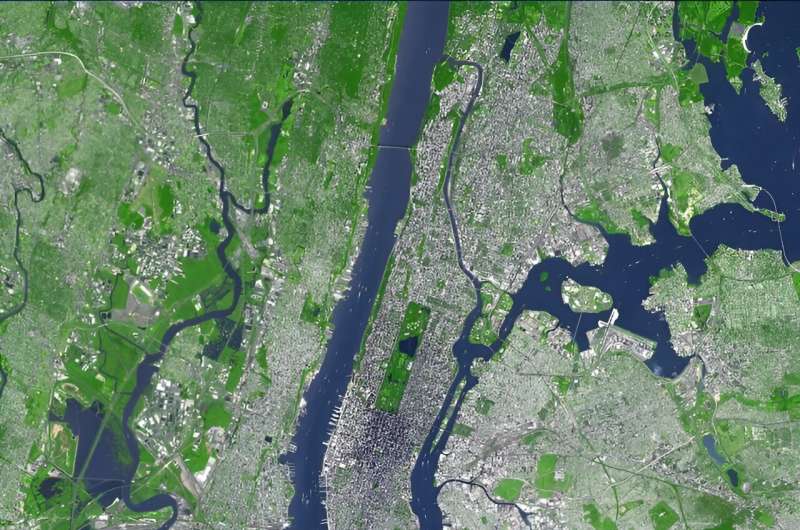This article has been reviewed according to Science X's editorial process and policies. Editors have highlighted the following attributes while ensuring the content's credibility:
fact-checked
peer-reviewed publication
trusted source
proofread
Amid a sweltering summer, a new study finds street trees thrive in NYC

So far this summer, New York City—like much of the country—has clocked more than 11 90-plus degree days. In addition to the increasing frequency of extreme heat waves, if it seems hotter in the city than in other environments, it typically is.
The urban heat island effect—brought on by tall buildings that limit air circulation, sizzling asphalt and pavement, and high concentrations of people living close together simultaneously running appliances and cars—can drive up temperatures in city neighborhoods by more than 7 degrees Fahrenheit.
The phenomenon hits the city's hottest, poorest neighborhoods hardest. Consequences can be serious. On average, an estimated 350 New Yorkers die prematurely because of hot weather. Heat waves are the deadliest extreme weather event in cities. Black city residents die from heat stress at double the rate of white residents.
But trees can and do help.
"The shade that trees produce helps to reduce the amount of sun that gets absorbed by the pavement in the urban environment. But also, from a biological perspective, trees allow more evapotranspiration, which also helps to cool the surrounding air," said Elizabeth Cook, urban ecosystem scientist and Barnard assistant professor in environmental science.
Cook was among a group of scientists to publish a study in PLOS ONE, titled "Large-Scale Determinants of Street Tree Growth Rates Across an Urban Environment," which represents one of the largest urban street tree growth studies ever conducted. It estimated individual growth rates for 126,362 street trees representing 59 species in NYC.
While accounting for factors like tree size—as a proxy for age—and the surrounding built environment, the study found species is the most important factor in determining growth rates. Despite varying growth rates, trees are growing well, especially in the most compromised areas.
"Examining citywide patterns of tree growth indicates that areas with a higher Social Vulnerability Index have higher than expected growth rates," found the report.
Brian Mailloux, adjunct senior research scientist of geochemistry at Lamont-Doherty Earth Observatory, which is part of the Columbia Climate School, and Barnard professor in environmental science and co-chair of the college's Environmental Science department, helped lead the study.
He and Cook believe, since previous work highlights that these vulnerable neighborhoods have significantly less green space and tree canopy cover than wealthier, less vulnerable neighborhoods, there's been room for more new trees and thus likely younger trees. Younger trees grow faster.
"This initiative highlights that vulnerable areas have fewer trees than wealthier neighborhoods," said Cook, which would prompt the new, more recent planting of younger trees. Younger trees grow faster. Anticipating this, the study's models accounted for younger trees, which would point to another reason.
"It suggests the city is paying attention to what tree species they plant.They're likely planting trees that typically have faster growth rates to help address the lack of trees in these communities," said Cook.
Notably, the years-long study has its roots in a high school project, led by Columbia School of Engineering alum Clare McGillis, now a graduate student at Northwestern University's McCormick School of Engineering, who attended Stuyvesant High School.
McGillis recognized that NYC had never been able to link the multiple street tree censuses to determine growth rates of trees because of errors in GPS coordinates in the city.
"This changed when Clare, as part of her Regeneron science fair project at Stuyvesant High School, realized you could link trees by addresses," said Mailloux, meaning that the city database always listed the closest building address to each tree.
For her project, McGillis tested the method on trees around the Columbia campus. These results were then linked to a database of tree growth collected by Barnard senior lecturer Terryanne Maenza-Gmelch's Introductory Environmental Science class.
"Some of the validation data we used for aligning the city's decadal street tree census, which was used to calculate growth rates, was collected by Clare and Barnard students in Terryanne's class," said Cook.
Both Mailloux and Cook believe this study can add important context to city planning. NYC is data rich and already has an interactive street tree map, which this study can feed into along with the NYC Parks Department Street Tree Planting initiatives.
"Trees are one form of a nature-based solution that cities are using to address things like the urban heat islands and flooding. But the challenge with nature-based solutions in cities is we don't yet have a good understanding of how well they function in different contexts within the city," said Cook.
"This paper gives us a better sense of what trees will do well and where and so that helps us to make more informed decisions about street tree planting throughout the city. It also starts to address the disparities in green space and trees as environmental justice concerns that we have in all cities."
More information: Brian J. Mailloux et al, Large-scale determinants of street tree growth rates across an urban environment, PLOS ONE (2024). DOI: 10.1371/journal.pone.0304447
Journal information: PLoS ONE
Provided by Earth Institute at Columbia University
This story is republished courtesy of Earth Institute, Columbia University http://blogs.ei.columbia.edu.


















